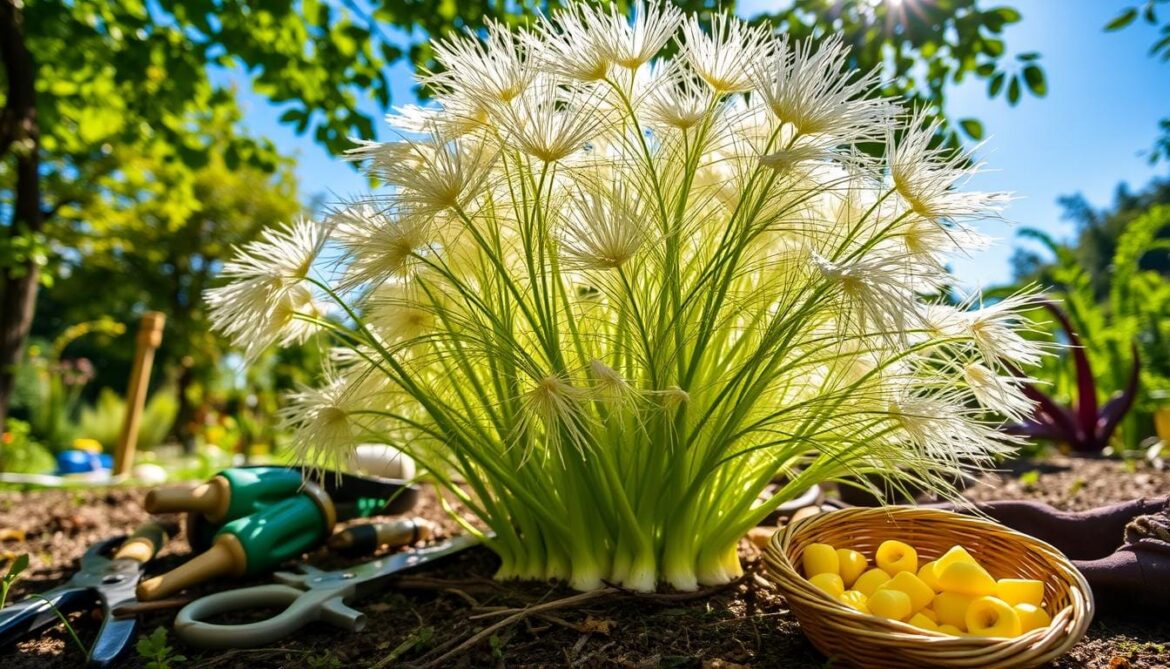The sound of dried fennel flower heads rustling hints at the treasures inside. Our journey to harvest fennel seeds starts with a love for nature’s gifts. We aim to turn our gardens into sources of fresh, aromatic seeds.
Fennel seed collection is not just a task—it’s an art that connects us to herbalists and gardeners of the past. With the fennel seed market set to reach $1.21 billion USD by 2030, now is the perfect time to dive into harvesting fennel seeds.
We’ll show you how to harvest these seeds from start to finish. Whether you’re an experienced gardener or just starting, our guide will change how you see fennel seed harvesting.
Key Takeaways
- Learn the optimal timing for harvesting fennel seeds
- Understand the best techniques for collecting and drying seeds
- Discover multiple uses for harvested fennel seeds
- Explore sustainable gardening practices
- Master the art of home seed collection
Understanding Fennel and Its Seeds
Fennel is a plant that combines culinary joy with agricultural interest. It shows how versatile and beneficial it can be for gardens and kitchens.
What is Fennel?
Fennel is a special plant for gardeners. It’s an aromatic herb from the Apiaceae family. It can be grown as a vegetable or spice. Foeniculum vulgare is a plant that looks good and is useful.
The Benefits of Growing Fennel
Fennel farming has many benefits for gardeners and food lovers. Here are some key advantages:
- Nutritional powerhouse with high levels of vitamins A, B, C, and E
- Rich in iron and potassium
- Low-calorie vegetable with high dietary fiber
- Multiple culinary and medicinal applications
“The entire fennel plant is edible, making it an incredibly versatile addition to any garden.” – Gardening Experts
Why Harvest Our Own Seeds?
Harvesting fennel seeds has many benefits. It lets us control seed quality, save money, and feel self-sufficient.
| Seed Harvesting Benefits | Details |
|---|---|
| Harvest Time | Late summer to autumn (August-September) |
| Seed Storage | Up to one year when properly stored |
| Harvesting Duration | Approximately 25 minutes for 4 ounces |
Our journey with fennel farming starts with its amazing qualities. From its health benefits to its many uses, fennel is a great addition to our gardens and kitchens.
Growing Fennel: An Overview
Fennel growing is an exciting journey for gardeners. It’s a chance to cultivate this versatile herb. Our guide will help you with the essential aspects of fennel plant care. This will ensure a successful and bountiful harvest.
Understanding the optimal conditions for fennel cultivation is key. Let’s explore the critical factors for healthy fennel growth.
Ideal Growing Conditions
Fennel thrives in specific environmental conditions. These conditions promote robust growth. Here are the critical elements for successful fennel plant care:
- Sunlight: Fennel needs full sun, with at least 6-8 hours of direct sunlight daily
- Soil: Well-draining, fertile soil with a pH between 5.5 and 6.8
- Temperature: Warm weather, ideally between 60-70°F
- Water: Consistent moisture, but avoid waterlogging
Choosing the Right Fennel Variety
Selecting the right fennel variety is important. We recommend considering these options:
| Variety | Best Use | Growth Characteristics |
|---|---|---|
| Florence Fennel | Bulb production | Compact, ideal for culinary use |
| Bronze Fennel | Ornamental and seed production | Attractive foliage, excellent for pollinators |
| Sweet Fennel | Seed harvesting | Tall plants with abundant seed production |
Common Pests and Diseases
Protecting your fennel plants from threats is vital. Key challenges include:
- Aphids: Tiny insects that can cause significant damage
- Armyworm larvae: Can create skeletonized leaves
- Fungal diseases: Including powdery mildew and downy mildew
*Pro Tip*: Encourage natural predators like ladybugs to help control aphid populations and maintain a balanced garden ecosystem.
With proper care and attention, your fennel plants can provide a bountiful harvest. Our guide aims to equip you with the knowledge to successfully grow and maintain your fennel crop.
When to Harvest Fennel Seeds
Harvesting fennel seeds is all about timing and watching closely. It’s a key part of gardening. We need to know when to pick the seeds for the best results.
It’s best to pick fennel seeds about 90 days after planting. Look for these signs to know they’re ready:
- Flower heads start to dry and turn brown
- Seeds turn a golden-brown color
- Seed clusters feel crisp and a bit brittle
- The flower cluster looks papery
Visual Cues for Seed Readiness
Knowing when to harvest fennel seeds takes attention. Mature seeds smell rich and aromatic and feel plump but dry. We aim to pick them before they fall off the plant for the best quality.
“The success of fennel seed collection lies in understanding the subtle signs of seed maturity.” – Gardening Expert
Timing for Optimal Flavor
Getting the timing right is key for the best flavor in fennel seeds. Seeds picked too soon might not taste as strong. Seeds that are too ripe can lose their flavor and break easily.
| Harvest Stage | Seed Characteristics | Flavor Potentail |
|---|---|---|
| Immature | Green, soft seeds | Low flavor intensity |
| Perfect Harvest | Golden-brown, crisp seeds | Maximum flavor concentration |
| Overripe | Dry, falling seeds | Diminished aromatic qualities |
Our method for harvesting fennel seeds ensures we get the best flavor. This makes them perfect for cooking and medicine.
Tools and Equipment for Harvesting
Getting ready to collect fennel seeds means picking the right tools and safety gear. We start by knowing the key equipment for efficient and safe fennel umbel harvesting.
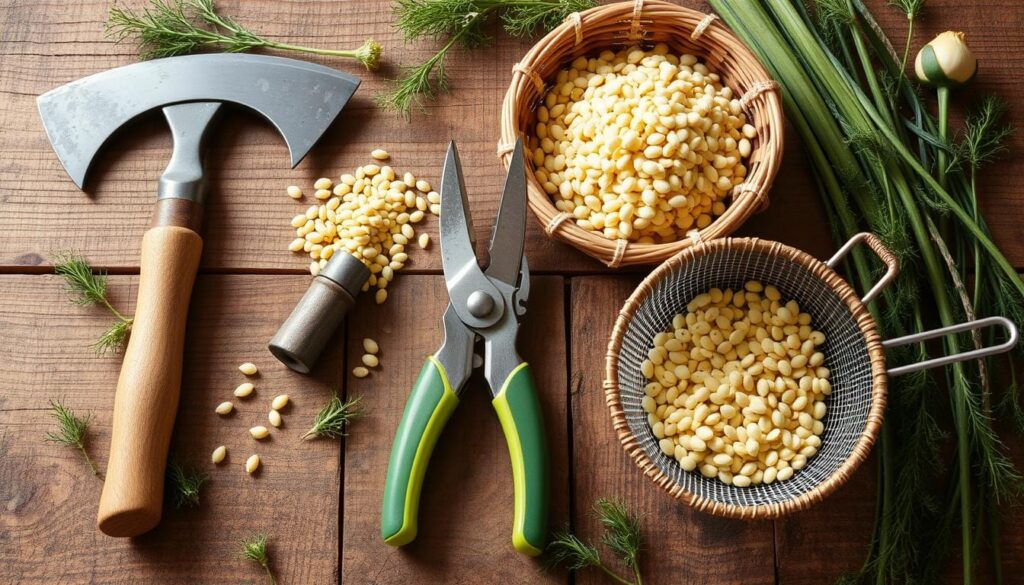
Essential Tools for Fennel Seed Harvesting
Here are the main tools for a successful harvest:
- Sharp pruning shears or scissors
- Clean collection containers
- Drying screens or trays
- Paper bags for seed storage
- Garden gloves
Safety Equipment Considerations
It’s important to protect ourselves while collecting fennel seeds. Fennel plants can sometimes irritate the skin. So, we suggest:
- Long-sleeved shirts
- Protective gardening gloves
- Safety glasses
- Dust mask for sensitive individuals
“Proper preparation prevents poor performance in seed harvesting.”
Choosing Quality Tools
Using high-quality gardening tools makes harvesting fennel umbels better and more fun. Stainless steel pruning shears with sharp blades help make clean cuts and protect the plant.
Our tools should be clean and well-kept to avoid spreading diseases. A quick clean with rubbing alcohol before and after use keeps them hygienic.
Step-by-Step Guide to Harvesting Fennel Seeds
Harvesting fennel seeds is a fun process that connects us with nature. Our guide will show you how to harvest and process fennel seeds. This way, you’ll get the best flavor and quality from your garden.
Preparing for the Harvest
First, gather the right tools. You’ll need a clean, dry container, sharp pruning shears, and gloves. Make sure your fennel plants are ready – seeds are ready 70-90 days after planting.
- Inspect fennel umbels for mature, brown seeds
- Wait until seeds turn a light brown color
- Choose a dry, sunny day for harvesting
The Actual Harvesting Process
Timing is key when harvesting fennel seeds. Our plants produce 100-200 seeds per umbel. So, it’s important to collect them carefully. Cut the seed heads mid-way down the stems, letting seeds fall into a container.
“Precision in harvesting ensures the best quality seeds for future use.”
Post-Harvest Handling
After harvesting, process seeds within 24 hours for the best quality. Spread them on a clean, dry surface to avoid moisture buildup.
| Harvesting Stage | Key Considerations |
|---|---|
| Seed Color | Light brown, dry appearance |
| Harvesting Time | 4-6 weeks after flowering |
| Processing Window | Within 24 hours of harvesting |
| Storage Duration | Up to 2 years when properly dried |
Remember, patience and attention to detail are key in successful fennel seed harvesting!
Drying Fennel Seeds
Proper drying of fennel seeds is key to keeping their quality and taste. The method used for processing can greatly affect how long they last and their use in cooking.
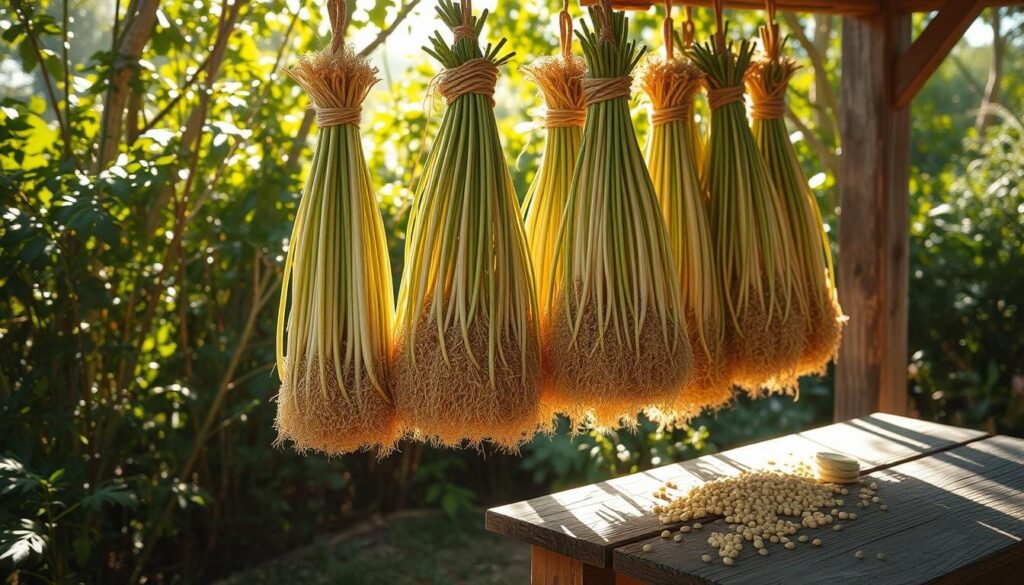
Our journey starts with knowing the essential steps for drying. We aim to remove all moisture while keeping the seeds’ oils and smell.
Importance of Drying for Storage
Drying fennel seeds is vital for several reasons:
- It stops mold from growing
- It keeps the seed’s flavor and strength
- It makes the seeds last longer
- It keeps the seeds good for planting later
Methods for Drying Seeds
There are several good ways to dry fennel seeds:
- Air Drying: Spread seeds on a flat surface in a dry, dark place
- Dehydrator Method: Use a food dehydrator at a low temperature
- Oven Drying: Put seeds in oven on the lowest setting for about an hour
Pro Tip: Make sure seeds are dry before storing to avoid spoilage from moisture.
We suggest checking seed dryness by crushing a few gently. If they break cleanly, they’re dry enough. A good harvesting method and drying techniques will give the best results for our fennel seed processing.
Storing Fennel Seeds
Keeping our fennel seeds fresh is key. We need to store them right to enjoy their taste for months. This way, we can make the most of our homegrown harvest.
Selecting the Perfect Storage Containers
The container you choose is very important. For keeping fennel seeds fresh, we suggest:
- Airtight glass jars
- Ceramic containers with tight-fitting lids
- Dark-colored storage vessels to protect from light
Best Practices for Seed Longevity
Our strategy for keeping fennel seeds fresh includes a few important steps:
- Choose a cool, dark place with a steady temperature
- Keep the temperature below 70°F (21°C)
- Stay away from direct sunlight and moisture
*Quality seeds are the foundation of future harvests*
| Storage Condition | Expected Seed Lifespan |
|---|---|
| Room Temperature (Airtight Container) | Up to 1 Year |
| Refrigerated | Up to 2 Years |
| Frozen | Up to 3 Years |
It’s important to check the seeds often. Look for greenish-brown seeds, which are fresh. If seeds are discolored or dull, throw them away to keep the quality high.
Monitoring Seed Quality
Regularly check your stored fennel seeds for:
- Moisture buildup
- Unusual odors
- Signs of insect damage
By following these tips, we can keep our fennel seeds fresh and tasty for our next cooking or gardening projects.
Common Mistakes to Avoid
Getting good at harvesting fennel seeds needs a lot of care. Many gardeners make big mistakes that hurt the quality of their seeds. Knowing these common errors can help you get a great harvest.
Timing Troubles in Seed Harvesting
It’s very important to pick fennel seeds at the perfect time. We often see gardeners make two big mistakes:
- They pick too early, getting seeds that are not ready
- They wait too long, and the seeds fall off or lose their strength
Critical Drying Technique Errors
Not drying fennel seeds right can ruin your whole harvest. Our studies show that bad drying can cause:
- Mold to grow
- Seeds to not grow well
- Seeds to lose their flavor
“The difference between a good and bad harvest often lies in the drying process.” – Herb Gardening Experts
To get your fennel seeds right, follow a careful plan. Watch the seeds closely and dry them well and evenly.
| Mistake | Consequences | Prevention Strategy |
|---|---|---|
| Premature Harvesting | Underdeveloped seeds | Wait until seeds turn brown and easily detach |
| Delayed Harvesting | Seed loss | Monitor plants daily during peak maturity |
| Poor Drying | Mold and reduced germination | Use well-ventilated, dry area with consistent temperature |
Mastering these techniques will make your fennel seed harvesting top-notch.
Sorting and Cleaning Fennel Seeds
After picking fennel seeds, it’s key to process them right to keep their quality. Our cleaning and sorting steps help keep the seeds’ taste, health, and nutritional value top-notch.
The fennel seed collection process has several key steps. These steps help get rid of dirt and pick the best seeds.
Initial Cleaning Techniques
- Separate seeds from stems and plant debris
- Use fine mesh screens for sifting
- Implement gentle winnowing methods
Sorting for Quality
We aim to find and get rid of any damaged or young seeds. This way, only the best seeds stay. The best fennel seeds should:
- Be uniform in color (yellowish-brown to greyish-brown)
- Measure between 4-10 mm in length
- Show no signs of mold or discoloration
Moisture Control in Seed Processing
Keeping the right moisture level is very important when processing fennel seeds. We try to keep the moisture below 8-10% to stop mold and keep the seeds good.
| Seed Quality Criteria | Recommended Standards |
|---|---|
| Moisture Content | Below 8-10% |
| Color | Yellowish-brown to greyish-brown |
| Size Range | 4-10 mm |
“Clean seeds are the foundation of successful cultivation and culinary excellence.”
Our method of collecting fennel seeds makes sure only the cleanest seeds are stored. This keeps their essential oils, taste, and planting ability safe.
Uses for Harvested Fennel Seeds
After we finish collecting our fennel seeds, we find a world of flavors and health benefits. These seeds are very useful in cooking and can help us feel better. Our hard work in growing fennel is truly worth it.
Culinary Delights in the Kitchen
Our fennel seeds can make simple dishes taste amazing. They add a sweet, anise-like flavor that makes food special.
- Seasoning for stir-fries and roasted vegetables
- Ingredient in homemade bread and biscotti
- Flavoring for broths and soups
- Essential component in spice blends
Medicinal Benefits of Fennel Seeds
Fennel seeds are not just for cooking. They also have health benefits that make growing fennel even more rewarding.
| Health Benefit | Description |
|---|---|
| Digestive Support | Helps reduce bloating and intestinal gas |
| Menopausal Symptoms | May alleviate common discomforts |
| Oral Health | Natural antimicrobial properties |
*”Fennel seeds are nature’s pharmacy, packed with antioxidants and healing properties.”*
Creative Seed Uses
We can use our fennel seeds in many ways:
- Fennel Seed Tea: Steep 1-2 teaspoons in boiling water
- Chew seeds for fresh breath
- Create herbal infusions
- Add to homemade skincare products
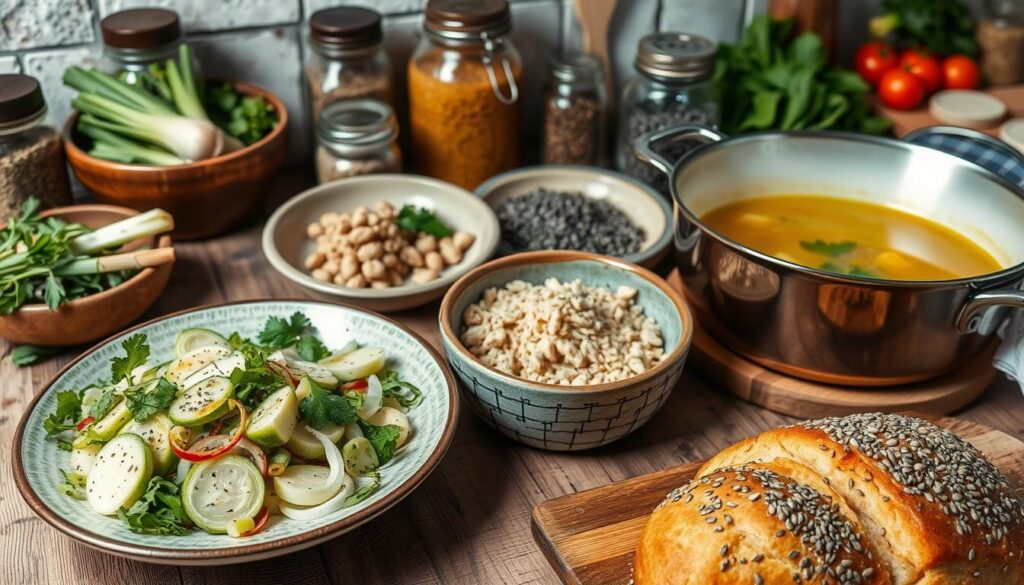
Propagating Fennel from Seeds
After we harvest fennel seeds, many gardeners want to keep growing fennel. Propagating fennel from seeds is a fun and rewarding process. It lets us complete the full cycle of growing fennel in our garden.
To grow fennel successfully, we need to know the right planting techniques. Our seeds can grow into thriving plants with the right care.
How to Plant Our Harvested Seeds
Here are the key steps to plant fennel seeds:
- Plant seeds about 1/4 inch deep in good soil
- Space seeds 12 inches apart in rows
- Make sure rows are 3 feet apart for best growth
- Choose a spot that gets full sun
Best Practices for Successful Germination
To grow fennel well, we must consider a few important factors:
| Germination Factor | Recommended Conditions |
|---|---|
| Sunlight | At least 6 hours of direct sunlight every day |
| Soil Temperature | Between 60-70°F (15-21°C) |
| Planting Depth | 0.25 inches |
| Plant Spacing | 12 inches between plants |
Our fennel growing plan should avoid too much fertilizer. Too many nutrients can hurt the plant’s smell. Instead, keep the soil moist and well-drained.
“Patience and careful attention are the keys to successful fennel propagation.” – Experienced Gardener
Fennel takes about 90 days to grow from seed to mature. By following these tips, we can grow a healthy and productive fennel crop in our garden.
Sharing Our Harvest
Our fennel seed collection is a great way to connect with other gardeners. It’s a chance to share our love for fennel farming. We can share our harvest with friends, family, and other gardening fans.
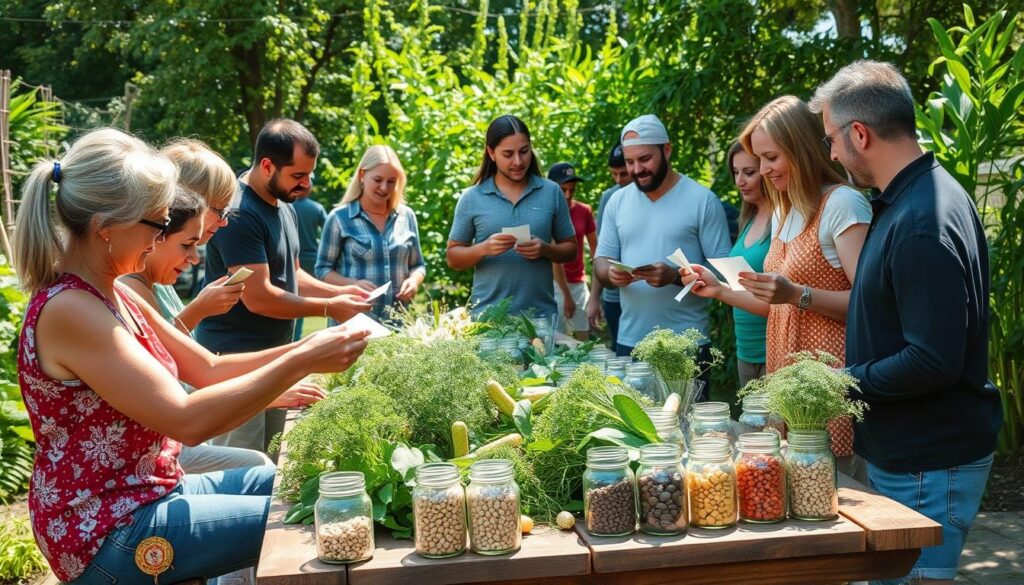
Packaging Seeds for Gifting
When we package our fennel seeds, we want them to stay fresh. Here are some tips:
- Use clean, dry paper envelopes or small glass containers
- Label seeds with harvest date and fennel variety
- Store in cool, dark places before distribution
- Include brief growing instructions
Seed Swap Events: Building Garden Communities
Seed swap events are great for trading our fennel seeds. They help us meet other gardeners and learn new things. We can:
- Meet local gardening enthusiasts
- Discover new fennel farming techniques
- Trade unique seed varieties
- Learn from experienced growers
“Sharing seeds is like sharing stories – each packet carries promise.” – Anonymous Gardener
Local Gardening Networks
We can find seed swap events through local clubs, community centers, and extension offices. Online platforms and social media groups also offer virtual exchanges.
| Seed Sharing Method | Benefits |
|---|---|
| Local Gardening Clubs | Direct personal connections |
| Community Centers | Structured exchange events |
| Online Platforms | Wider geographic reach |
| Social Media Groups | Instant communication |
Remember, every seed shared is a chance for a new garden to bloom!
The Environmental Impact of Harvesting Seeds
Fennel growing is more than just a hobby. It can greatly help our environment. By choosing how we harvest seeds, we can positively affect local wildlife.
Fennel plants do a lot for our planet. They are homes for many helpful insects. This creates a web of life in our gardens.
Sustainable Gardening Practices
Our way of growing fennel can help the planet. We can do this by:
- Using less commercial seeds
- Keeping local plant varieties alive
- Helping pollinators
- Lowering carbon emissions from farming
Benefits to Local Ecosystems
Fennel plants are key for local wildlife. They help pollinators and other beneficial insects.
| Ecosystem Benefit | Impact |
|---|---|
| Pollinator Support | Attracts bees, butterflies, and beneficial wasps |
| Genetic Diversity | Preserves local plant genetic variations |
| Soil Health | Promotes natural nutrient cycling |
“Every seed we save is a step towards ecological restoration.” – Sustainable Gardening Network
By growing fennel mindfully, we help the environment. Our small actions can make a big difference. They support local ecosystems and sustainable farming.
Troubleshooting Common Issues
Understanding common challenges in fennel plant care is key. Our guide will help you tackle these problems in fennel farming.
Addressing Seed Germination Challenges
Germinating fennel seeds can be tough. Several factors might stop seeds from sprouting:
- Soil temperature below 60°F
- Planting depth too deep
- Inadequate moisture
- Old or low-quality seeds
Pro tip: Plant seeds 1/4 inch deep. Keep the soil moist for best germination.
Managing Post-Harvest Pest Problems
After you harvest fennel seeds, you need to watch out for pests. Common pests include:
- Aphids: Look for leaf discoloration and stunted growth
- Armyworm larvae: Find skeletonized leaves
- Cutworms: Check for seedlings severed at soil line
“Prevention is always better than cure in fennel plant care.” – Gardening Expert
Disease Prevention Strategies
Fennel can get several fungal diseases. These diseases can harm your plants:
- Cercospora leaf blight
- Downy mildew
- Powdery mildew
- Rust disease
To avoid these diseases, use well-draining soil. Also, space plants right and choose disease-resistant seeds.
Expanding Our Herb Garden
Now that we’ve mastered growing fennel, it’s time to explore companion planting. We’re going to expand our herb garden. Fennel cultivation opens up new chances to make our garden diverse and productive.
Complementary Herbs for Fennel Growing
Choosing the right companion plants can boost our fennel growing. Some herbs pair well with fennel, making our garden a peaceful place.
- Mint: Helps repel pests
- Lavender: Attracts beneficial pollinators
- Chamomile: Improves overall plant health
- Cilantro: Supports natural pest control
Companion Planting Strategies
Placing herbs wisely can greatly improve our garden’s yield and health. When growing fennel, we need to think about spacing and which plants go together.
| Herb | Benefits for Fennel | Recommended Distance |
|---|---|---|
| Mint | Pest deterrence | 12-18 inches |
| Lavender | Pollinator attraction | 15-24 inches |
| Chamomile | Soil health improvement | 10-15 inches |
“In a well-designed garden, every plant has a purpose and supports its neighbors.”
Learning about companion planting helps us build a strong and fruitful herb garden. By picking herbs that help fennel grow, we can make our garden even better. This way, we’ll enjoy a rich harvest.
Conclusion and Encouragement to Start
Our journey in harvesting fennel seeds is more than just gardening. It’s about sustainable farming and better nutrition. By learning to grow fennel, we open up a world of flavors and health benefits. It changes how we garden with herbs.
Harvesting fennel seeds brings us closer to our food. We get fresh, aromatic seeds full of minerals like Calcium, Iron, and Magnesium. Each seed is a chance for growth and new recipes in our kitchen.
The Joys of Growing and Harvesting Fennel Seeds
Our adventure with fennel seeds lets us control our herb supply. With the skills we’ve learned, we can always have quality seeds for cooking and health. These skills will help us grow more herbs in the future.
Next Steps in Our Seed Harvesting Journey
Now that we’ve learned about fennel seed harvesting, we’re ready for more. We’ll practice our skills, try different fennel types, and share our harvests. The journey of seed saving is exciting, and our fennel seed adventure is just starting.
